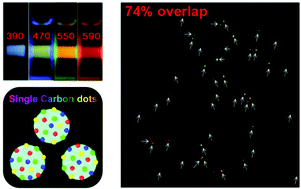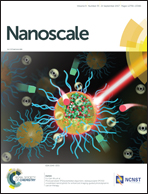Full-colour carbon dots: integration of multiple emission centres into single particles†
Abstract
The single particle emission behaviours of our previously reported excitation-dependent full-colour carbon dots (F–C dots) have been analyzed by a single-particle fluorescence imaging technique. The co-localization of the F–C dots excited with different wavelengths shows that single F–C dots can also be excited with multiple energies. The co-localization of the F–C dots that emit at different colour regions under the same excitation wavelength or different excitation wavelengths shows that single F–C dots have a broad emission band from blue to red, but the emission intensities in different colour regions vary from one particle to another. So this study concretely proves that the full colour emissions are single particle behaviours; they are different from the other type of excitation dependent full-colour emission carbon dots whose full-colour behaviour originates from the large heterogeneity in both particle size and the structures of the ensemble. Then the origination of the full-colour emission at the single dot level was further studied by comparing the emission properties of the F–C dots and the small molecular byproducts, and it is found that the emissions of the dozens of molecular byproducts can also cover the full visible regions. And the emission positions of F–C dots are very similar to those of the byproducts at the same excitations, but they show different lifetimes. So a mechanism for the full colour emissions of F–C dots is proposed to originate from the hybridization of multiple small emissive molecules on the emissive carbon cores. This single particle level understanding of full-colour emission properties will pave the way towards the development of single dot imaging or tracking.



 Please wait while we load your content...
Please wait while we load your content...